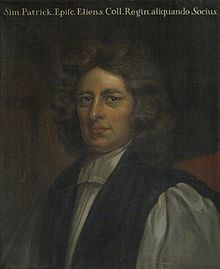Simon Patrick | |
|---|---|
| Bishop of Ely | |
 | |
| Church | Church of England |
| Diocese | Diocese of Ely |
| In office | 1691–1707 |
| Predecessor | Francis Turner |
| Successor | John Moore |
| Other post(s) | Dean of Peterborough (1679–1689) Bishop of Chichester (1689–1691) |
| Personal details | |
| Born | 8 September 1626 |
| Died | 31 May 1707 (aged 80) |
| Buried | Ely Cathedral |
| Nationality | British |
| Denomination | Anglican |
| Parents | Henry Patrick (father) |
| Spouse | Penelope Jephson |
| Children | Simon |
| Education | Boston Grammar School |
| Alma mater | Queens' College, Cambridge |


Simon Patrick (8 September 1626 – 31 May 1707) was an English theologian and bishop.
Life
He was born at Gainsborough, Lincolnshire, eldest son of Henry Patrick, a wealthy merchant, on 8 September 1626, and attended Boston Grammar School. He entered Queens' College, Cambridge, in 1644,[1] and after taking orders in 1651 became successively chaplain to Sir Walter St. John and vicar of Battersea, Surrey. He was afterwards (1662) preferred to the rectory of St. Paul's, Covent Garden, London, where he continued to labour during the plague.
He was appointed Dean of Peterborough in 1679, and Bishop of Chichester in 1689, in which year he was employed, along with others of the new bishops, to settle the affairs of the Church in Ireland. In 1691 he was translated to the see of Ely, which he held until his death on 31 May 1707. He was buried in Ely Cathedral.[2] His memorial is by Edward Stanton.[3]
He had Dalham Hall built.
Works
His sermons and devotional writings are numerous, and his Commentary on the Historical and Poetical Books of the Old Testament, in 10 vols., going as far as the Song of Solomon, was reprinted in the 1810 Critical Commentary on the Old and New Testaments and Apocrypha, along with works of Richard Arnald, Moses Lowman, William Lowth, and Daniel Whitby.[2]
Patrick's Friendly Debate between a Conformist and a Nonconformist was a controversial tract, defending the Five Mile Act.[2] It excited considerable feeling at the time of its publication in 1668. Among replies was one from Samuel Rolle as Philagathus.[4] He also contributed to a volume of Poems upon Divine and Moral Subjects (1719).
The first collected edition of his works appeared at Oxford in 1858 (9 vols.), edited by Alexander Taylor; a small Autobiography was published also at Oxford in 1839.[2]
He is the author of the anti-semitic pamphlet, "Jewish Hypocrisie, A Caveat To The Present Generation."
Theology
Simon Patrick, was influenced by prominent Arminian theologians as Henry Hammond, and the Cambridge Platonists; and was criticized for his Arminian belief.[5] He is described by historians as an influential Arminian Anglican.[6]
Marriage
In 1675 he married Penelope Jephson (died 1725), a daughter of Maj. Gen. William Jephson (1609–1658), a highly influential Member of Parliament for Stockbridge, and also a substantial landowner in Mallow, County Cork, by his wife Alicia Dynham,[7] a daughter of Sir John Dynham of Boarstall Tower, Buckinghamshire and Penelope Wenman. They had three children, two of whom died young.[8]
Notes and references
Citations
- ^ "Simon Patrick (PTRK644S)". A Cambridge Alumni Database. University of Cambridge.
- ^ a b c d Overton, John Henry (1895). . In Lee, Sidney (ed.). Dictionary of National Biography. Vol. 44. London: Smith, Elder & Co.
- ^ Dictionary of British Sculptors 1660-1851 by Rupert Gunnis p.367
- ^ Smith, Charlotte Fell (1897). . In Lee, Sidney (ed.). Dictionary of National Biography. Vol. 49. London: Smith, Elder & Co.
- ^ Feingold 1990, p. 259. Patrick himself was particularly subject to accusations of Arminianism because he based his tutorial instruction on the work of the Laudian Henry Hammond. His early opposition to predestination had been strengthened by the teaching of his mentor, the Cambridge Platonist John Smith [...] Simon Patrick's library catalogue from this period gives some indication of what these forbidden books would have been since it includes works by prominent Arminian theologians such as Espicopius, Grotius, and Hammond.
- ^ Coffey 2006, p. 227. Besides Sancroft, there were other young men at Cambridge in the early 1650s who were to become influential Arminian Anglicans: Isaac Barrow [...], John Tillotson [...], Simon Patrick [...], Edward Stillingfleet [...], Richard Kidder [...], Thomas Tenison. [...] The most important influences on them were clearly the Cambridge Platonists, and the Anglican Arminian, Henry Hammond. But Redemption Redeemed may have helped to confirm their rejection of Calvinism.
- ^ Jephson, Maurice Denham An Anglo-Irish Miscellany, some Records of the Jephsons of Mallow Dublin Allen Figgis 1964
- ^ The printed autobiography of Simon Patrick calls his wife a "grandchild to the lady Durham (sic) of Borstall". The Auto-Biography of Simon Patrick, Bishop of Ely [1]
Sources
- Coffey, John (2006). John Goodwin and the Puritan Revolution : Religion and Intellectual Change in Seventeenth-Century England. Woodbridge: The Boydell Press.
- Feingold, Mordechai (1990). Before Newton: The Life and Times of Isaac Barrow. Cambridge: Cambridge university press.
Attribution
- This article incorporates text from a publication now in the public domain: Chisholm, Hugh, ed. (1911). "Patrick, Simon". Encyclopædia Britannica (11th ed.). Cambridge University Press.
External links
 Media related to Simon Patrick at Wikimedia Commons
Media related to Simon Patrick at Wikimedia Commons- Rt Rev Simon Patrick
- Facsimile of Simon Patrick's preface to Hugo Grotius' Truths of Christian Religion. Scanned by Elms College Alumnae Library.
- 1626 births
- 1707 deaths
- 17th-century Church of England bishops
- 18th-century Church of England bishops
- Alumni of Queens' College, Cambridge
- Arminian ministers
- Arminian theologians
- Bishops of Chichester
- Bishops of Ely
- Canons of Westminster
- Deans of Peterborough
- English theologians
- People educated at Boston Grammar School
- People from Gainsborough, Lincolnshire
- 17th-century Anglican theologians
- 18th-century Anglican theologians








